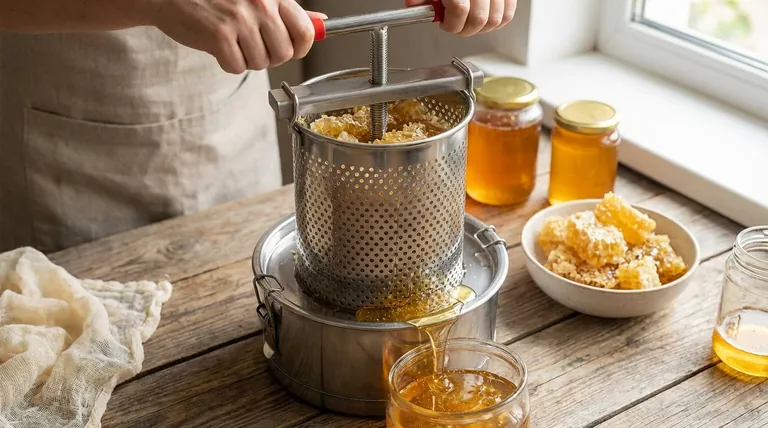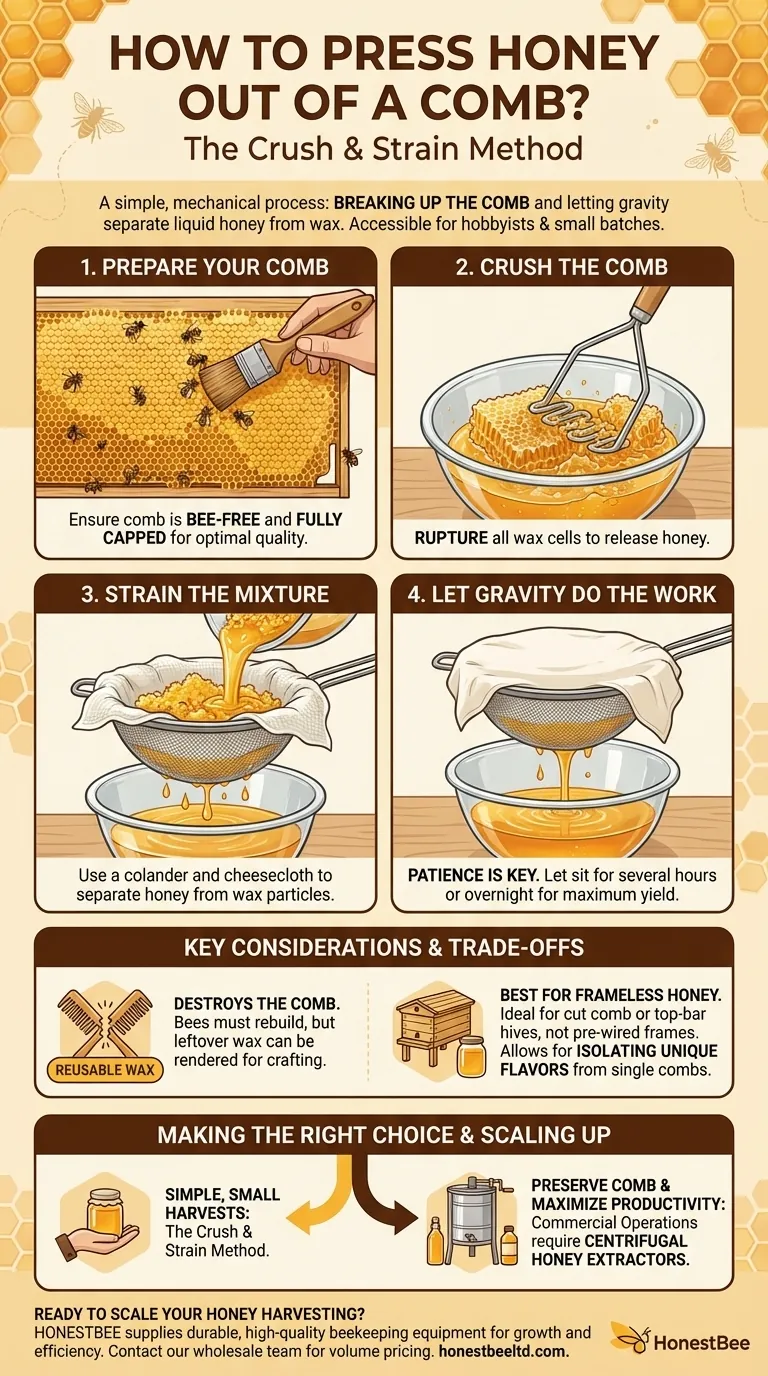The most direct way to press honey out of a comb is through a simple "crush and strain" method. This involves breaking up the honeycomb and letting gravity, sometimes with a little pressure, separate the liquid honey from the wax. You can accomplish this easily using common kitchen tools like a colander, a strainer, or even a potato ricer for smaller batches.
At its core, separating honey from comb is a mechanical process of breaking the wax cells to release the liquid honey. While centrifugal extractors are used in commercial operations, the crush and strain method is the most accessible and straightforward approach for hobbyists or those with natural, frameless comb.

The Crush and Strain Method: A Step-by-Step Guide
This technique is the foundation of small-scale honey harvesting. It requires no specialized equipment and works perfectly for top-bar hives or any situation where you have cut comb.
Step 1: Prepare Your Comb
Before you begin, ensure your comb is ready. It should be removed from the hive and brushed completely free of bees.
Ideally, the honeycomb should be fully capped, meaning the bees have sealed the cells with wax. This indicates the honey has the correct moisture content and is ready for long-term storage without spoiling.
Step 2: Crush the Comb
Place your cut honeycomb into a clean, food-grade bucket or a large bowl. Using a clean utensil like a potato masher or even your clean hands, break up and crush the comb thoroughly.
The goal is to rupture all of the wax cells to release the honey they contain.
Step 3: Strain the Mixture
Set up a straining system by placing a colander or a large mesh strainer over a second clean bucket or bowl. For a finer strain that removes more wax particles, you can line the colander with cheesecloth.
Pour the crushed comb and honey mixture into your strainer.
Step 4: Let Gravity Do the Work
The most important step is patience. Cover the straining setup to keep out dust and debris, and let it sit for several hours, or even overnight. Gravity will slowly pull the liquid honey down through the strainer, leaving the wax behind.
For a slightly higher yield, you can gently press down on the wax in the strainer with a spoon or spatula to push more honey out.
Common Pitfalls and Key Considerations
Understanding the implications of this method is crucial for any beekeeper or honey enthusiast. It is a simple process, but it comes with distinct trade-offs compared to other methods.
This Method Destroys the Comb
The primary downside of crushing and straining is that it destroys the beeswax comb. Bees expend significant energy to build this comb, and when it's preserved (as with a centrifugal extractor), they can refill it much faster.
However, the leftover wax is not waste. It can be cleaned and rendered for use in candles, balms, and other crafting projects.
It's Best for Frameless Honey
This method is ideal for comb that isn't built into a pre-wired frame. Cut-comb honey, chunk honey, or honey from a top-bar hive are perfect candidates.
Using this method on frames with wire or plastic foundation is impractical and messy. Those frames are designed specifically for centrifugal extraction.
You Can Isolate Unique Flavors
A unique benefit of pressing honey is the ability to process one comb at a time. This allows you to taste the subtle variations in flavor and color from different parts of the hive, which reflect the specific nectar sources the bees were visiting. These nuances are often lost when honey from many frames is mixed together in a large extractor.
Making the Right Choice for Your Goal
- If your primary focus is simplicity and you have a small harvest: The crush and strain method is perfect, requiring only basic kitchen equipment.
- If your primary focus is preserving the comb for your bees to reuse: This method is not suitable; you should investigate a centrifugal honey extractor.
- If your primary focus is experiencing unique, hive-specific flavors: Pressing one comb at a time and bottling it separately is the best way to appreciate the subtle differences.
Ultimately, pressing your own honey is a rewarding way to enjoy a pure, unprocessed product straight from the source.
Summary Table:
| Method | Best For | Key Consideration |
|---|---|---|
| Crush and Strain | Hobbyists, Top-Bar Hives, Small Batches | Destroys the comb but yields pure, flavorful honey |
| Centrifugal Extractor | Commercial Operations, Reusable Frames | Preserves comb for bees to refill, requires investment |
Ready to Scale Your Honey Harvesting?
For commercial apiaries and beekeeping equipment distributors, the right tools make all the difference. While the crush and strain method is excellent for small batches, professional operations require efficient, high-yield equipment like centrifugal honey extractors to preserve comb and maximize productivity.
HONESTBEE supplies the durable, high-quality beekeeping supplies and equipment you need to succeed. Let us help you equip your operation for growth and efficiency.
Contact our wholesale team today to discuss your equipment needs and volume pricing.
Visual Guide

Related Products
- Stainless Steel Honey Press Wax Press with Tank
- Stainless Steel Manual Honey Press with Guard for Pressing Honey and Wax
- Electric Flatting and Embossing Machine with Tray for Beekeeping
- Honey Wax Separating Wax Press with Metal Screw Wax Separator Machine
- Vertical Motor Kits for 2 3 4 Frame Electric Honey Extractors
People Also Ask
- What are the key features of a honey press? Maximize Yield with Durable, Efficient Extraction
- How does the press method for extracting honey work? A Simple, Low-Cost Guide for Beekeepers
- What are the benefits of the screw design in a stainless steel honey pump? Preserve Honey Quality and Integrity
- How was the honey press cleaned after use? Quick vs. Deep Cleaning Methods Explained
- What happens to the wax after pressing in a honey press? A Guide to Maximizing Your Hive's Yield



















